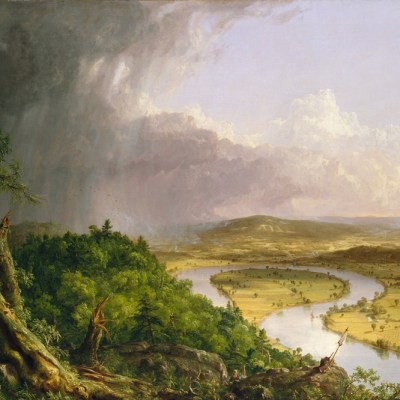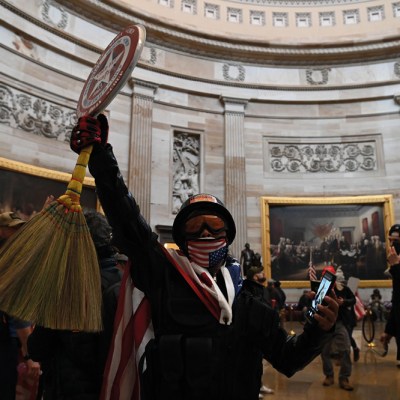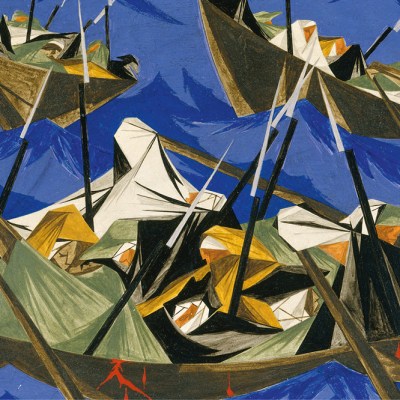From the February 2025 issue of Apollo. Preview and subscribe here.
In 1790 the painter Charles Willson Peale opened the doors to his Philadelphia home, where visitors could come and admire the fossils, coins and antiquities he’d been scavenging over the years, the taxidermy he’d stuffed himself, the many portraits he’d painted of Revolutionary War heroes, and diverse relics of the ‘Indian, African, or other savage people’. Basically anything ‘promising to be useful in advancing knowledge and the arts’ in America, he announced in a letter to a Philadelphia newspaper that envisioned, one day, ‘a great national museum’. Peale was also candid about his failings. Almost no method, he confessed, had been able to protect his collection of stuffed American birds against worms, moths and sundry ‘depredations by the vermin of America’.
There it is, in the country’s first press release for a public art museum, a question nagging its curators now more than ever: how deeply should they apologise? Two new rehangs in New York reflect two extremes in the political resituation of art in the past decade. The Met has carefully revised its American Wing, which turned 100 in the autumn. It was last redone in 2012, before Barack Obama had finished his first term. The Brooklyn Museum, to celebrate its bicentenary, has started from scratch in its American galleries. These were last rehung in 2016, before Colin Kaepernick took the knee, before a President Trump. The two rehangs – one quiet, one brassy – echo Peale’s confessional mood in what is now a very different country.
By brassy, I mean showing a jaw-dropping zeal for moral improvement. The Brooklyn Museum’s portraits now hang at seated rather than standing height. This belittlement hopes to call out ‘the wealth and privilege in societies built on displacement, colonialism, and enslavement’. A bookshelf in the centre of one gallery displays volumes on race and postcolonial theory beside questionably relevant works by Georgia O’Keeffe and low-hanging fruit like the ‘wannabe cowboy’ Frederic Remington. Formerly chronological, the works from pre-Columbian to Gen Z are now hung thematically, many jumbled together salon style. Fine – it’s fun for us – but it’s harder for the visual presentation of their many arguments. Especially when these works are accompanied by text blocks of estranging jargon that border on manifestos: ‘While in progress, we endeavour toward a politics of articulation and a principle of elaboration.’
There is plenty of elaboration to do on Peale’s Mrs. David Forman and Child from around 1785, a canvas borrowing from Byzantine and Dutch tropes to depict the wife of a Revolutionary general. Instead, wall text by the activist Victoria Von Blaque describes ‘a white woman who did not use her lily-white pussy powers for good. Rather, she partnered with the patriarchy to uphold the ideals of white supremacy.’ (Her husband owned slaves.) Find the microscopically detailed, 12-foot-long canvas of a storm in the Rocky Mountains by Albert Bierstadt (1866), one of the more cinematic Hudson River painters. More than half the label concerns the politics behind the naming of the peak. Nothing on divine mediation or the Native Americans in the foreground, Bierstadt’s crux. Conventional as they may have been, the old labels at least named some of Bierstadt’s aims and, through them, the fact that his movement ‘occasionally inserted Native bodies into depictions of the American wilderness to reinforce the stereotype that Indigenous people were equally untamed’. It’s a point grounded in, and enriching of, the picture itself. Bierstadt sought dominion of the American west through submission to it.
A Storm in the Rocky Mountains, Mt. Rosalie (1866), Albert Bierstadt. Brooklyn Museum, New York
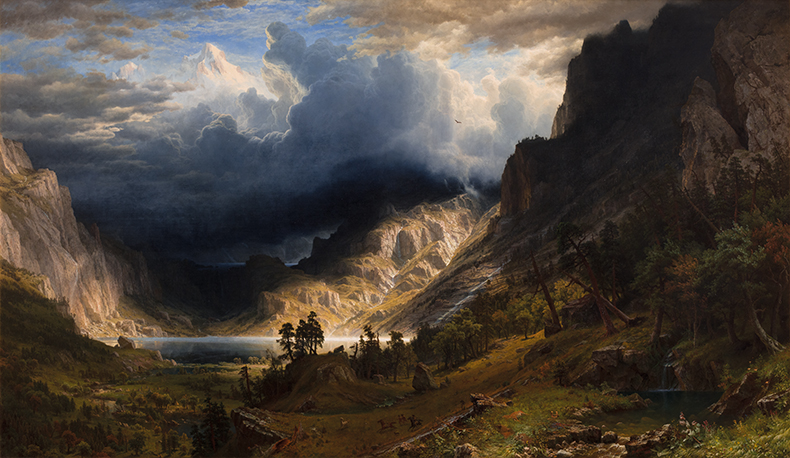
Aside from all that, Bierstadt is seductive. Just ask the Spanish-speaking couple who, skipping the label, asked me to photograph them in front of this impressive painting. Inanimate objects cannot stand morally guilty, and yet the urge to apologise for them haunts our museums. Why? One answer may come from the art historian Svetlana Alpers, whose essay ‘Is Art History?’ (1977) identified a growing trend among scholars to read individual artworks as records of human history rather than as independent expressions of aesthetics. At the Brooklyn Museum, this trend feels responsible for the classification of George Luks’s Sheet Scene (Hester Street) (1905), a bustling streetscape of downtown Manhattan, as antisemitic. (Some subjects’ noses are legible, while Luks had previously drawn caricatures of Jewish peddlers.)
But the self-flagellation at the Brooklyn Museum reveals a more insular fear: the charge of elitism. Museums are full of expensive things. Many represented the height of status back when people like Peale, say, regarded ‘savages’ with anthropological bemusement, or legally owned them. Take two starkly different sugar bowls by the Revolutionary-era silversmith Myer Myers: a sober finial one on display at the Brooklyn Museum, and a flouncy engraved rococo one at the Met. Which do they explain more: America’s conflicted notion of self, or what the Brooklyn Museum calls an ‘intersection of power dynamics’ inherent in slave-produced sugar? Myers was Jewish. The Brooklyn’s website reveals this. The Met’s does not. Does that fact complicate the question?
The interrogation can be infinite. Saddled – some say blessed – with many such artefacts, the Brooklyn has calculated every element of its rehang, which they have peppily titled ‘Toward Joy’, to reject the elitism associated with museums. It may help sell tickets, or may not. What it does recall is the museum’s founding in 1824 as the Brooklyn Apprentice’s Library Association, with a target clientele of ‘unattached young males in the churchgoing community of 9,000 residents’ who ‘spent their idle hours drinking, card playing and creating a general nuisance’ (wrote its principal librarian in 1987). Arts institutions have always worried that everyday Americans will slip through the cracks excluded or uneducated. Should these places teach us, or should they prepare us to educate ourselves? If both, in what proportions?
The proportions have been variable at least since the Library merged, in 1848, with the Brooklyn Association to amass and exhibit the art on display today. Subsequent ‘great national museums’ such as the Met, the Museum of Fine Arts in Boston and the Art Institute of Chicago – the triumvirate founded in the 1870s – set about acquiring European masters. Critics such as S.R. Kohler, writing in 1887, feared in his country’s painters a ‘lack of originality of technique’ – a fear shared by other American critics at the time. That was an aesthetic worry, shaped by the fear that exemplary art led no further than itself.
At the same time, others fretted over access. The Met was sequestered in posh Central Park. So a three-part exhibition in an experimental locale – the working-class East Village in 1895 – paired American painters from Bierstadt to Remington in a gymnasium on East Broadway, about a block from Luks’s Hester Street, alongside paintings by Gérôme, Reynolds and other European artists. Admission was free, but the tenement reformer Abram Bernheim was not alone in fretting that the poor would ‘resent the display of the possessions of the rich’. He stood happily corrected. ‘Droves of people’ showed up eager to hear about ‘the special merit of this masterpiece and that particular school’, reported Edward King, one of the organisers.
American art was ennobling itself, and the Met went further in 1924, with an outbuilding one entered through the facade of a Federal-style bank that the museum had saved from demolition in the Financial District and reassembled in the Park. Inside this American Wing, a painstaking display of American period rooms implied a radical thing to the city’s working men and homemaking women: the American way of life deserved no less than aesthetic reverence. Beauty was now civics. ‘The phrase “Art for Art’s sake” has no place in a healthy republic,’ explained Henry Watson Kent, one of the Wing’s founders. ‘Art for the People’s sake is the motto of the American museum today.’ Further expansions proved success. Attendance surged, the museum announced in 1945, ‘because of the stress on Americanism during the war and the destruction abroad of old-time arts and crafts’. In 1980 the Wing joined the main building symbolically, via a great shawl of conservatory glass. In 2012, the galleries expanded around the period rooms.
Installation view of, to the left of the doorway, William ‘Billy’ Lee: Portrait in Tar (2016) by Titus Kaphar, hanging in the Alexandria Ballroom of the reinstalled American Wing of the Metropolitan Museum of Art. Photo: © Metropolitan Museum of Art
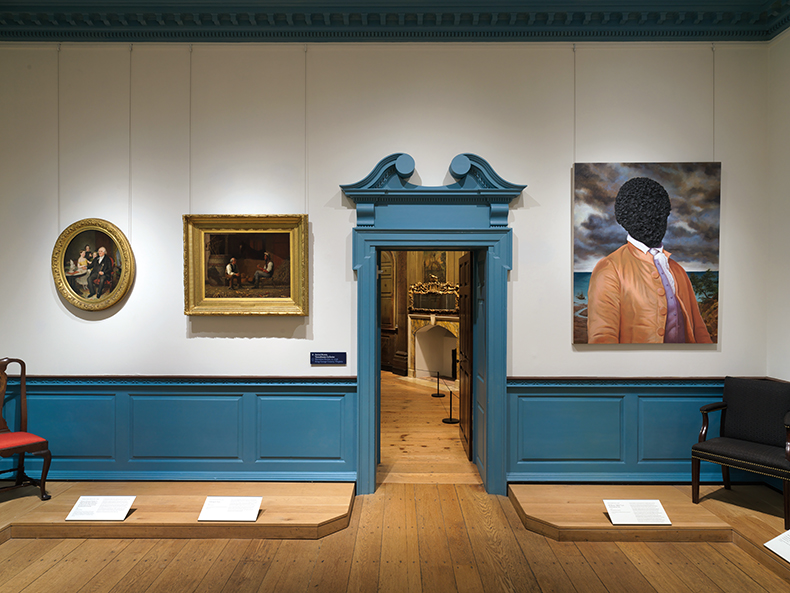
The current rehang is so subtle that the Met’s publicists couldn’t immediately say which of the 600-plus works had been swapped in. The wing still proceeds in chronological order, from Peale’s mercantile republic to O’Keeffe’s desert modernism. Except hard questions about enslavement, native people and the ironies of liberty seem to have been beefed up in the labels. The advantage here is that ample gallery space allows more room for the confrontation to breathe – and more room to avoid labels, though these don’t overdo it. Chronology may impose a narrative, but it is still the clearest way to scrutinise a slice of history. This feels evident when the Met drops a postmodern history painting into the story. In one period room full of George Washingtons, is John Trumbull’s portrait of 1780, with the general’s turbaned Black slave demonstrating the ‘European Orientalist convention associated with Black figures.’ Beside it now appears an imagined portrait of Washington’s slave William Lee, from 2016, by the Michigan-born painter Titus Kaphar. This Lee is dressed more Virginianly, except the face is obscured by thick peaks of tar: we know little about Lee, least of all what he looked like. Trumbull painted the picture from memory, in London, and embellished it for British tastes.
But context is everything. A Kaphar also hangs at the Brooklyn Museum: his copy of Frans Hals’s Family Group in a Landscape, with the Dutch family blanked out in white, leaving their Black servant to stare alone. Amid its jumbled salon gallery, a section called ‘Witness’ stressing minorities, Kaphar’s revision fades into a sort of group realisation of Diversity, Equity and Inclusion. As American museums continue to acquire copycat classicists in Kaphar’s vein, artists such as Kehinde Wiley and Renee Cox who critique the past by altering 18th-century compositions, the Met at least tries to let the new, often didactic movement in history painting leave its viewers space to make their own interpretation.
Washington Crossing the Delaware (1851), Emanuel Leutze. Metropolitan Museum of Art, New York
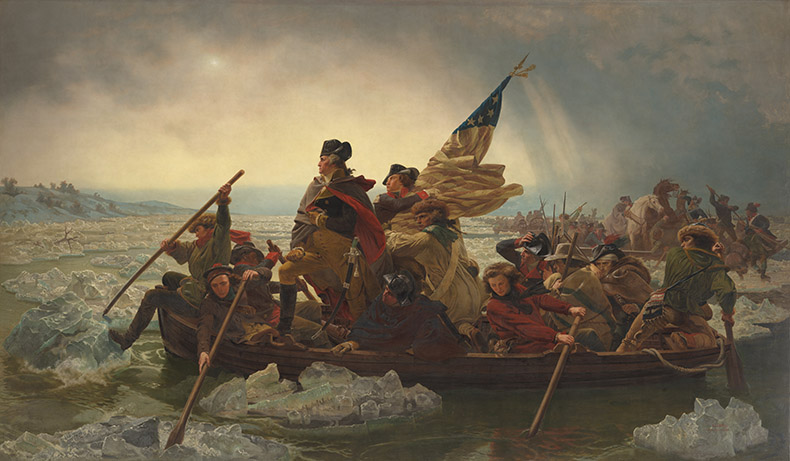
The Brooklyn Museum’s previous hang claimed, correctly, that ‘as the face of America is changing, becoming more diverse, so too are ideas of what constitutes “American” art’. Indigenous art, this seems partly to have meant, is a staple of the Brooklyn and most other encyclopaedic American collections. Peale would be proud. What is really accelerating now – and has been simmering for two centuries – is the pressure to curate a moral compass that ‘unattached young males’ have never really asked for, least of all the most recent batch, which is welcoming a new administration promising no more liberal apologies.
It feels like more than precedent that the Met’s largest portrait of nationalism, Emanuel Leutze’s 20-foot-long Washington Crossing the Delaware (1851), still occupies its domineering place in the Wing. (The Brooklyn Museum’s own obligatory Washington, a full-length by Gilbert Stuart acquired in 1945, hides by the storage entrance.) In the Met’s new label, the Akwesasne Mohawk historian Scott Manning Stevens explains the Black rower visible by the general’s knee: ‘Leutze wants to paint our better angels. He shows this democratic vision towards freedom – that it’s not just Washington alone.’ Call it hokey, but it was the centrepiece of Abraham Lincoln’s Sanitary Fair of 1861, a fundraiser for Union hospitals in the Civil War, where it hung near a Frederic Edwin Church of the Andes and another Bierstadt view of the Rockies, both also big. Contemporary viewers, the Met label says, ‘understood these two landscapes as metaphors for the conflict between the South and the North’, with Washington representing ‘the urgency of preserving the Union’. (Washington invented the peaceful transition of power in the modern world.) Both landscapes flank the Leutze. To the side hangs Jacob Lawrence’s post-cubist revision of Leutze from 1954, where Washington’s crew is obscure and pathetic, battered by rain and hiding under their blankets. Is this a Black artist responding, or just realism? This imposing quartet explains the evolution of interpretation in America, from patriotic to partisan to cynical, while respecting our own. With luck, this is the direction American museums will take in the next ten years.
Panel 10 from Struggle: From the History of the American People (1954–56), Jacob Lawrence. Metropolitan Museum of Art, New York
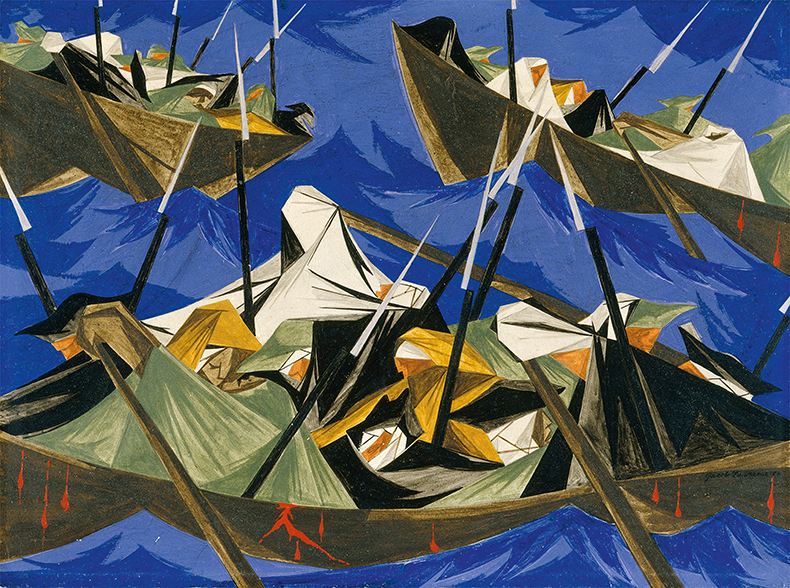
From the February 2025 issue of Apollo. Preview and subscribe here.
